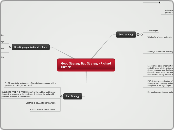Good Strategy Bad Strategy - Richard Rumelt
Good strategy
The Kernel
Diagnosis: defines or explains the nature of the challenge: what's going on here?
Guiding Policy: (a) overall approach for dealing with the obstacles identified in the diagnosis; (b) define a method of dealing with challenge and rule out array of approaches
Create advantage by anticipating actions and reactions of others; reduces complexity and ambiguity in the situation; exploits leverage by concentrating effort on pivotal or decisive point; establishes coherence in approach and policy
Coherent actions: coordinated steps designed to accomplish the guiding policy
define goals
set limited number of good objectives for each goal
Achieve strategic coordination or coherence must be imposed on a system by policy and design; use proximate (near enough) objectives
Strategy is visible as coordinated action imposed on a system. good strategy and good organisation lie is specialising on the right activities and imposing only the essential amount of coordination.
Key strength
Window(s) of opportunity, internal & external
Leverage: power from focusing minds, energy and action
Anticipation
Pivot points to magnify the effects of focused energy and resources
Concentration and the balance between flows threshold effects
Leadership. (a) An important duty of any leader is to absorb a large part of the complexity and ambiguity, passing on to the organisation a simpler problem - one that is solvable. (b) The more uncertain and dynamic the situation, the more proximate a strategic objectives must be. (c) Take a strong position and create options, not looking far ahead.
FOCUS. (a) the coordination of policies that produce Ezra power through their interacting and overlapping effects. (b) the application of that power to the right target
Key weaknesses. Internal and external
Breaking organisational culture
Simplification
Fragment operating units then triage
Change norms and work related norms, usually replacing alpha individuals
Reverse some of earlier fragmentation with new coordinating mechanism
Bad Strategy
FLUFF superficial restatement of the obvious combined with s generous sprinkling of buzzword
FAILURE TO FACE THE PROBLEM: define the problem and the way through it in response to the challenge. Anticipate the real world problems that need to be overcome.
MISTAKING GOALS FOR STRATEGY.
BAD STRATEGIC OBJECTIVES.
